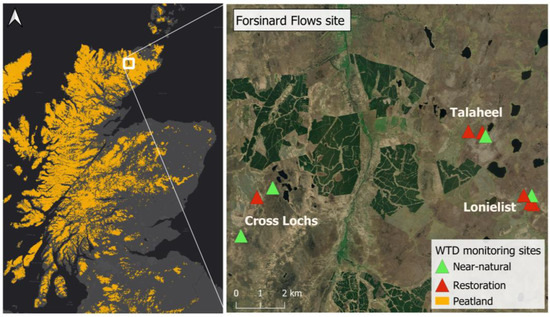12
Peatland restoration has become a common land-use management practice in recent years, with the water table depth (WTD) being one of the key monitoring elements, where it is used as a proxy for various ecosystem functions. Regular, uninterrupted, and spatially representative WTD data in situ can be difficult to collect, and therefore, remotely sensed data offer an attractive alternative for landscape-scale monitoring. In this study, we illustrate the application of Sentinel-1 SAR backscatter for water table depth monitoring in near-natural and restored blanket bogs in the Flow Country of northern Scotland. Among the study sites, the near-natural peatlands presented the smallest fluctuations in the WTD (with depths typically between 0 and 15 cm) and had the most stable radar signal throughout the year (~3 to 4 dB amplitude). Previously drained and afforested peatlands undergoing restoration management were found to have higher WTD fluctuations (depths up to 35 cm), which were also reflected in higher shifts in the radar backscatter (up to a ~6 dB difference within a year). Sites where more advanced restoration methods have been applied, however, were associated with shallower water table depths and smoother surfaces. Three models—simple linear regression, multiple linear regression, and the random forest model—were evaluated for their potential to predict water table dynamics in peatlands using Sentinel-1 SAR backscatter. The random forest model was found to be the most suited, with the highest correlation scores, lowest RMSE values, and overall good temporal fit (R2 = 0.66, RMSE = 2.1 cm), and multiple linear regression came in a close second (R2 = 0.59, RMSE = 4.5 cm). The impact of standing water, terrain ruggedness, and the ridge and furrow aspect on the model correlation scores was tested but found not to have a statistically significant influence. We propose that this approach, using Sentinel-1 and random forest models to predict the WTD, has strong potential and should be tested in a wider range of peatland sites.
You must log in or register to comment.


